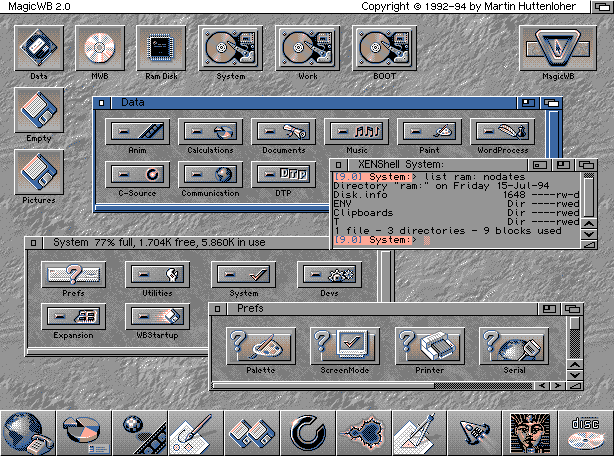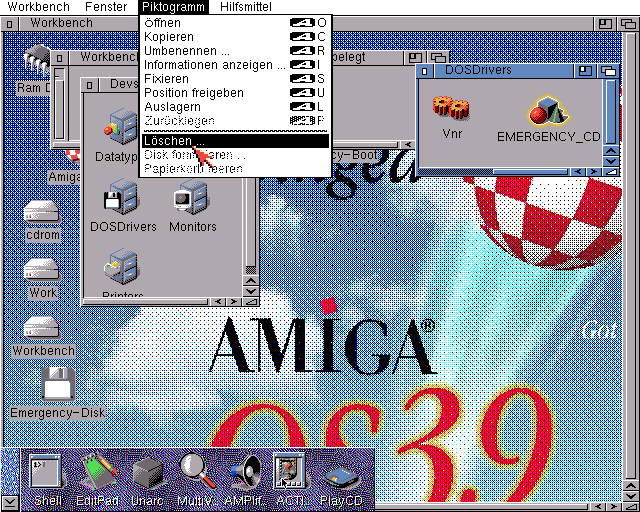Amiga Workbench 3.1 Hdf

Mass storage?The original Amiga primarily used 3.5 inch double density floppy disks. These were able to hold up to 880k.
It was possible to connect up to four floppy drives via the floppy port and one or more harddisk using special harddisk controllers.The MIST board does not support physical floppy disks nor real harddisks. Instead the only mass storage option available on the MIST board is the SD card slot. This is being used to emulate floppy disks and harddisks not only for the Amiga but also for the Atari ST.It is likely possible to support USB thumb drives as well. This has not been implemented yet.Floppy disksThe Minimig MIST core supports raw floppy disk images usually using the.ADF file extension.
The MIST supports up to four such disk images.To use such flpppy disk images simply copy them onto the SD card used in your MIST board. Once booted into Kickstart press F12 to open the main menu. Images for floppy drives DF0: and DF1: can directly be selected on the main menu page. Floppy drives DF2: and DF3: have to be activated using the + key on the keypad.Hard diskEmulating a harddisk with the Minimig MIST core is very simple. Since the Amiga 600 IDE controller is being emulated workbench 3.1 is needed with a matching kickstart rom.The additional disk images from the workbench 3.1 setup are required (install disk, fonts disk, extras disk, locale disk and storage disk). Copy all these disk images to the SD card.Harddisk image fileAlso required is a big file to be used as the harddisk.
Under Linux these can easily be created using the dd command: dd if=/dev/zero of=hd64m.hdf count=64k bs=1kThis creates a file named hd64m.hdf which is exactly 64MBytes big resulting in a harddisk similar to a 60 MBytes harddisk.Copy this file to the same SD card as the floppy disk images.Setting up the MISTInsert the SD card and power up your MIST board. Open the OSD (hit F12) and select Install 3.1 disk image for DF0.Go to the hard disk settings submenu and enable A600 IDE emulation and select the hd64m.hdf file as the Master Hardfile (disk img). Set the Slave to be Disabled.You are now done doing the MIST specific stuff. In the next steps will format and partition the harddisk as if it was a real harddisk on a real Amiga.Setting up the harddiskOn the workbench open the Install drawer and then the HDTools drawer. Run the HDToolBox.
First click on 'Change Drive Type' and in the following menu select 'Define New.' Click 'Read Configuration' to adjust the image size. The total size displayed should equal the size of your image (63MB in this case). You may also specify a new 'Manufacturer name' and a 'Drive Name'. Strata fff1c88 foto 3d cx 2j for mac. Hit 'ok' twice. You can ignore the warning about the missing file.Select 'Save Changes to Drive' and then 'Partition Drive'.In the Partitioning Dialog select the right partition and click the 'Delete Partition' button.
I've been using Amibian for about 2 days now as an A1200 with Workbench 3.1 and a 4Gb expansion. I've managed to install a classic 'Workbench Lite' HDF file, which is by Bloodwych of EAB Abime, but as I don't understand all the enhancements to the Workbench 3.1 that he's installed, there are some problems.

Then drag the 'Size' cursor all the way to the right to increase the size of the remaining first partition. Important if you want to make the hard disk bootable afterwards: Set the partition name to DH0.Then select the 'Change.' In the following dialog set the checkmark at 'Directory Cache', change the MaxTransfer value to '0x1fe00' and click ok.In the main menu once more select 'Save Changes to Drive'.Click 'Exit'. The Amiga OS will now reboot. Once this has finished the hard disk will show up on the desktop.You can now format your hard disk by selecting it first and then right clicking for the menu and selecting 'Format Disk.' In the Icon menu. Give your new drive a nice name and hit 'Quick Format'.Your new hard disk is now usable.Make the harddisk bootableTo boot without a workbench floppy image inserted you need to the make the harddisk image bootable.
To do so run the Install program from the Install 3.1 disk and follow the instructions.Importing and exporting filesAmiga emulators often have the ability to access the hosts file system directly and present it to the emulated amiga as a hard disk. An example for such an emulator is. Its ability to access the hosts file system directly is explained in detail in the section of its manual.This emulator can mount ADF floppy disk images as well as the HDF harddisk image created in the previous section. Once the Minimig/MIST has been used to initialize the HDF image on the SD card it can be transferred back to the PC to be used with an emulator.In order to export or import single files to or from the hard disk image copy your hd64m.hdf back to your PC or simply access it directly on the SD card inserted into the PC. Start fs-uae-launcher and select the hdf file as a hard disk image. Also choose the host file system as a second hard drive and boot the emulator.
You'll now get two icons on the workbench. One is the hard disk image created with Minimig/MIST, the second one is your PCs file system. You can now copy files forth and back between both disks and move data from your PC into your Minimig/MIST hard disk image or back.When finished just copy the hd64m.hdf modified by the emulator back to the SD card and boot your MIST board with it in order to use the newly installed files.
Or if you worked directly with the image in the SD card just plug it back into the MIST board.Using Amiga floppy and hard disk images under LinuxLinux PCs can directly access the contents of Amiga floppy and hard disk images. A floppy disk can simply be mounted by specifying the affs file system type.
The following command will make the contents of the floppy.adf floppy image available at /mnt mount -t affs -o loop floppy.adf /mntUsing harddisk images (disk img type as explained above) requires only one step more. First the parted tool needs to be used to figure out where inside the image the partition is stored: $ parted hardfile.hdfWARNING: You are not superuser. Watch out for permissions.GNU Parted 2.3Using hardfile.hdfWelcome to GNU Parted! Type 'help' to view a list of commands.(parted) u b(parted) pPralloc = 0, Reserved = 2, blocksize = 1, root block at 79254Model: (file)Disk hardfile.hdf: 80936960BSector size (logical/physical): 512B/512BPartition Table: amigaNumber Start End Size File system Name Flags1 258048B 80898047B 80640000B affs3 DH0 bootThis tells us that the first partition starts at byte 258048 and is 80640000 bytes long.
Setting up a hard drive with Workbench 3.1 in WinUAE1. IntroductionSetting up a virtual hard drive in WinUAE is easier than you think. Once you have it running, your emulated Amiga will be a lot more fun and powerful.As a gamer you can forget about the mad disk swapping in the Point & Click adventures. With a hard drive you will also be able to use WHDLoad, which lets you install hundreds of classic Amiga games.If you're into more serious stuff, you can run powerful applications such as Photogenics, Image FX and Final Writer. You will even be able to surf the web and lurk on IRC with your emulated Amiga.